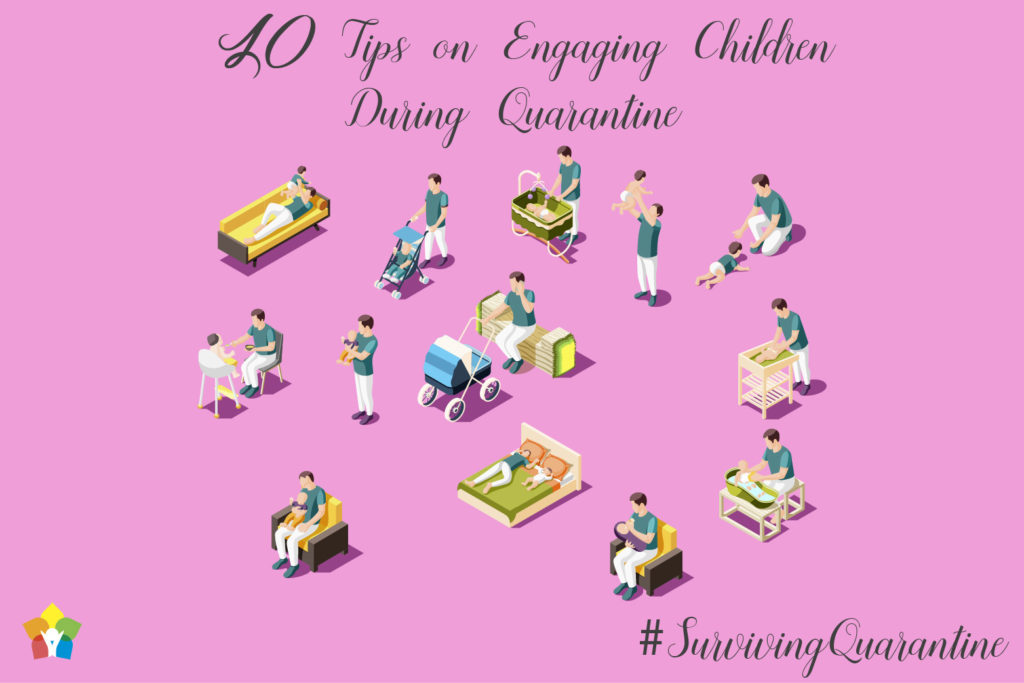10 Tips on Engaging Children During Quarantine (Coming Up With The Almost Perfect Routine)

It can be extremely hard for parents to constantly meaningfully engage their children & ensure that their learning doesn’t stop during quarantine.
There has been a lot of discussion on ‘setting a routine’ for children. Routine is a structure with the help of which one proceeds to complete daily activities. Children don’t have a lot of control in their lives, but routines can give them a sense of organization, stability, and comfort. Thus children may thrive with a structure regulated by parents.
However it is also important to ensure that we are not fixated on routines & give children of all age groups the required flexibility & space. It is also important to acknowledge that at a time like this, it might be difficult for parents to chalk out or follow the routine that is regularly followed and they might have to tweak it accordingly.
Here are 10 tips to ensure you manage your children with a mix of study, leisure, play & screen time during the lockdown:
1. Do not get fixated on a routine.
Following a tentative routine may be great for parents to manage younger children better but it might not be so for preteens and adolescent children who might want some more flexibility in their schedule. Thus getting fixated on a set routine might create resistance over a period of time. Thus a trial and error might be the best method to see what works with your child. Ensure you create the routines or time tables in consultation with your children. Hear their voices & be flexible.
2. Create checklists to maintain motivation.
Parents can create checklists of tasks for children and hang it on the wall. Give points or stars for each task done and devise a score system where the person with the highest points is rewarded with something simple like getting to eat their favorite dish. This will be good to retain enthusiasm for a longer time. Ensure that the checklists are a mix of study, fun & leisure.
3. Make a toy, break a toy
Introduce creative approaches in learning like making toys out of things easily available at home. This will be a fun way of learning certain concepts and also keep kids engaged. (Click here for ideas – http://arvindguptatoys.com/)
4. Study material available online is a valuable resource.
Use of resource material and tutorials that are now made available online during the lockdown can be of great help! Part of the screen time can be utilized to actively engage the kids in learning something new. The parents can access various apps or sites which are now offering free academic videos.
Check out UNESCO’s comprehensive list of educational applications, platforms and resources that aim to help parents, teachers, schools and school administrators facilitate student learning and provide social care and interaction during periods of school closure.
Also check Khan Academy & Mumma Diaries & This Extensive Excel Sheet of Learning Resources
Adolescents can create online study groups and circles to recommend videos/ tutorials or maybe just to share science memes
5. Encourage movement and physical health.
As a general rule, movement is super important and should be an essential part of your child’s day. Movement helps your child strengthen their body and organize and calm their brain. Check out this article for Indoor Movement Activities for Kids at Home.
For older children recreating online dance tutorials, TikTok dances videos, Tabata or Zumba exercise videos can be one of the modes to promote physical activity. This may also put screen time to a more fruitful use.
6. Activities- Quizzing, Creating, and Mixing it up
If there are more children at home (adults can participate too) creating a playful quiz based on general knowledge or trivia based on everyone’s interest. You can try making a small tent using bedsheets and pillows in one corner or under the bed as a make-play activity. A time maybe allotted for this in their weekly schedules. Indoor family games carrom, chess, ludo, card games, board games are also engaging and make time fly smoother. There are apps for all of these but if you don’t want it to add to the screentime, look for offline options.
7. Each one, Teach one
Parents who have access to the internet can definitely support other parents online, by taking up a few classes or doing online tutoring for a few children together. This can lead to online interaction for the kids as well. Parents can also consider taking up specific tasks and subjects to teach which they can focus on, based on their strengths, so that the burden/onus of teaching doesn’t fall on one parent. Older siblings can also participate in teaching if they like.
8. Ensure regulated but definite access to screen time
Ensure there is a definite, scheduled screen time for the child apart from the television hours with the family and online classes or tuition so that the children feel like they have their private access to the internet or gaming. This might prevent children from feeling like they have lack of agency. Let your kids socialise with their peers digitally.
9. External intervention for studies might be effective
Intervention from an external teacher or guide can be useful for study time, as there will be more accountability and may keep the child more engaged than only a parental intervention.
10. Encouraging children to catch up on their sleep by compromising screen time.
If parents are worried about excessive screen time during the day, especially out of boredom, they can encourage children to take naps rather than spending time on screen. This might not work with all older kids but if it does it may help reduce screen time, and might be considered a better option.
Click here for an excellent list of exercises and activities for children collated by the good people at Leher.
***
(If you like this article, please consider donating to our ongoing donation drive to Help Families of Sexual Abuse Victims in Mumbai Survive the Lockdown)








